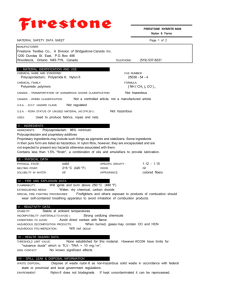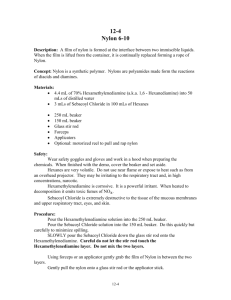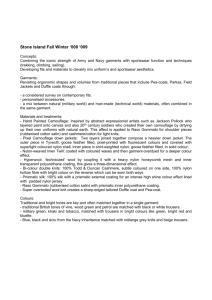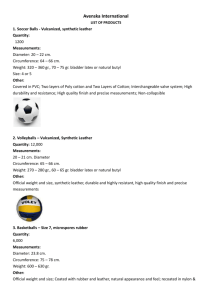document
advertisement
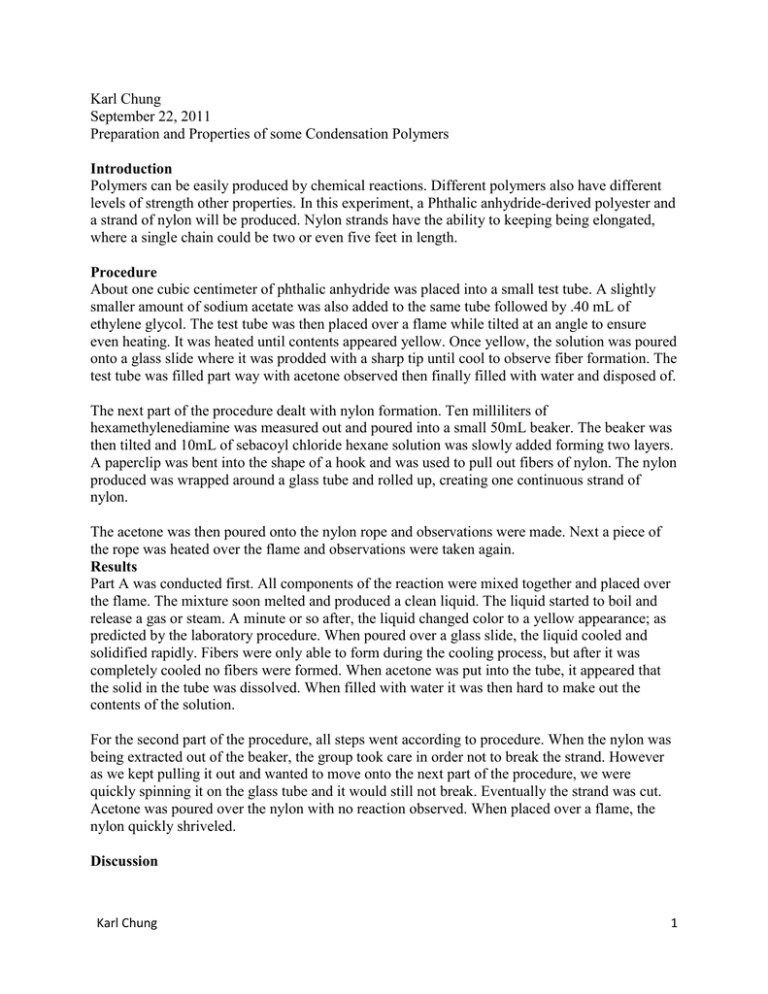
Karl Chung September 22, 2011 Preparation and Properties of some Condensation Polymers Introduction Polymers can be easily produced by chemical reactions. Different polymers also have different levels of strength other properties. In this experiment, a Phthalic anhydride-derived polyester and a strand of nylon will be produced. Nylon strands have the ability to keeping being elongated, where a single chain could be two or even five feet in length. Procedure About one cubic centimeter of phthalic anhydride was placed into a small test tube. A slightly smaller amount of sodium acetate was also added to the same tube followed by .40 mL of ethylene glycol. The test tube was then placed over a flame while tilted at an angle to ensure even heating. It was heated until contents appeared yellow. Once yellow, the solution was poured onto a glass slide where it was prodded with a sharp tip until cool to observe fiber formation. The test tube was filled part way with acetone observed then finally filled with water and disposed of. The next part of the procedure dealt with nylon formation. Ten milliliters of hexamethylenediamine was measured out and poured into a small 50mL beaker. The beaker was then tilted and 10mL of sebacoyl chloride hexane solution was slowly added forming two layers. A paperclip was bent into the shape of a hook and was used to pull out fibers of nylon. The nylon produced was wrapped around a glass tube and rolled up, creating one continuous strand of nylon. The acetone was then poured onto the nylon rope and observations were made. Next a piece of the rope was heated over the flame and observations were taken again. Results Part A was conducted first. All components of the reaction were mixed together and placed over the flame. The mixture soon melted and produced a clean liquid. The liquid started to boil and release a gas or steam. A minute or so after, the liquid changed color to a yellow appearance; as predicted by the laboratory procedure. When poured over a glass slide, the liquid cooled and solidified rapidly. Fibers were only able to form during the cooling process, but after it was completely cooled no fibers were formed. When acetone was put into the tube, it appeared that the solid in the tube was dissolved. When filled with water it was then hard to make out the contents of the solution. For the second part of the procedure, all steps went according to procedure. When the nylon was being extracted out of the beaker, the group took care in order not to break the strand. However as we kept pulling it out and wanted to move onto the next part of the procedure, we were quickly spinning it on the glass tube and it would still not break. Eventually the strand was cut. Acetone was poured over the nylon with no reaction observed. When placed over a flame, the nylon quickly shriveled. Discussion Karl Chung 1 Nylon was not affected by the acetone, however the polymer produced from part A was. This suggests that nylon is thermosetting polymer and the polyester is a thermoplastic due to the observations taken at different temperatures. The nylon chain was able to be extended as long as the reactants were there. The polyester fibers could not extend more than a centimeter in length. Questions 1: Ethylene Glycol Reaction: (C2H6O2)n + (C8H6O4)n → (C10H8O4)n + (H2O)n Glycerin Reaction: (C3H5(OH)3)n + (C8H4O3)n → (C11H6O3)n + (H2O)n 2: aEthylene glycol- phthalic produced a clear polymer that was able to dissolve in acetone. Fibers are able to be pulled out while cooling. glycerin-phthalic produced a pale yellow. This was also able to dissolve in acetone and fibers were able to be pulled out while cooling but not after it completely solidified. bIf there were a 2:1 ratio of glycol and glycerin, it would be expected that longer chains of mers could be produced due the increase in potential reactions with the carboxylic group. More molecule interaction leads to longer chains. 3: aC6H16N2 + C10H16Cl2O2 → C2O2(CH2)8N2H2(CH2)8 bNylon forms easily because as the chain is extended, new mers are added covalently in addition to the attractive vanderwals force between the linear chains of nylon. The double bonds created between oxygen molecules also contributes to the strength of the chain. cThe purpose of using extra hexamethylenediamine was to ensure that the reaction had a sufficient amount of reactant in order to proceed at a speed that could match the pulling of the nylon rope from the beaker by the group members. Conclusion Lab successfully taught the process of condensation. The different properties of the polymers produced shows that not all polymer reactions form the same product. The nylon was unaffected by acetone however the polyester was easily dissolved. References MATERIALS SCIENCE FOR ENGINEERS LABORATORY MANUAL Karl Chung 2 FALL 2005 Messler, Robert W. The Essence of Materials for Engineers. Sudbury, MA: Jones and Bartlett Learning, 2011. Print. Karl Chung 3




